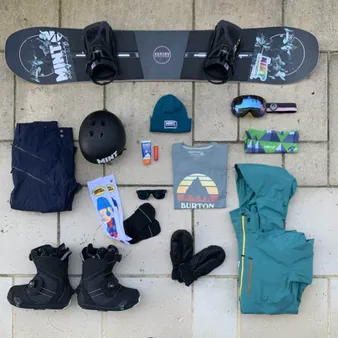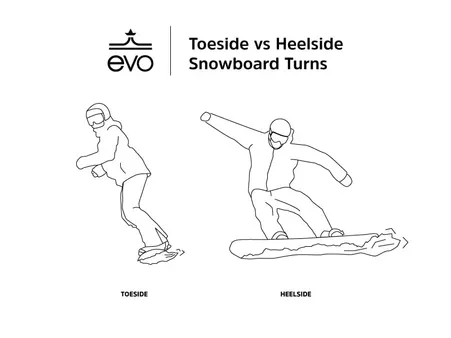Table of Contents
Welcome to Kizworld, your gateway to unlocking the exhilarating world of snowboarding. As a beginner, embarking on this thrilling adventure can seem daunting, but with the right guidance and a touch of determination, you'll be carving your way down slopes like a pro in no time. This comprehensive guide will equip you with everything you need to know to get started with snowboarding, from choosing the appropriate gear to mastering fundamental techniques and progressing to more advanced moves. Let kizworld be your trusted companion as you embark on this exhilarating journey.
How to Get Started with Snowboarding as a Beginner: A Comprehensive Guide
I. Choosing the Right Snowboard
Choosing the Right Snowboard
Beginners, take note: your snowboarding experience hinges on selecting the right snowboard. Consider these factors to find your perfect match:
- Height: Measure from head to toe without shoes. This determines your snowboard's length, typically ranging from 120 to 160 centimeters.
- Weight: Your weight impacts the snowboard's flex and stiffness. A heavier rider needs a stiffer board for better control.
- Skill Level: Choose a snowboard that complements your skill level. Beginners should look for boards designed for easy turning and forgiveness.
- Riding Style: All-mountain boards offer versatility for various terrains. Freestyle boards excel in parks and pipes, while freeride boards conquer off-piste adventures.
Optimal Snowboard Length: A Formula for Success
Height Range | Snowboard Length Range |
4'9" - 5'2" (145 - 158 cm) | 120 - 125 cm |
5'3" - 5'6" (160 - 168 cm) | 125 - 130 cm |
5'7" - 5'10" (170 - 178 cm) | 130 - 135 cm |
5'11" - 6'2" (180 - 188 cm) | 135 - 140 cm |
6'3" - 6'6" (191 - 198 cm) | 140 - 145 cm |
6'7" - 6'9" (201 - 206 cm) | 145 - 150 cm |
Once you've chosen the right snowboard, visit Kizworld for top-notch snowboarding gear, apparel, and accessories. Browse our extensive collection to elevate your snowboarding experience and conquer the slopes with confidence. Snowboarding for Beginners: Your Journey From Novice to Thrilling Rides
II. Getting the Right Gear
Getting the Right Gear
To start your snowboarding journey with ease and comfort, selecting the appropriate gear is fundamental. The primary components of snowboarding equipment include the snowboard, boots, bindings, helmet, goggles, and protective clothing. Each element plays a crucial role in ensuring your safety and enhancing your overall snowboarding experience.
A snowboard is the centerpiece of your gear, and its size and shape should complement your height, weight, and skill level. When choosing boots, consider factors like fit, support, and comfort. Bindings act as the link between your boots and the snowboard, providing control and stability. A helmet is an absolute necessity for head protection, while goggles shield your eyes from the sun, wind, and snow, improving visibility and clarity.
Choosing the Right Snowboard:
- Beginners should opt for softer boards as they are easier to control and maneuver.
- Shorter boards are more manageable for learners but may be less stable at higher speeds.
- Wider boards provide more stability and floatation in powder.
It is worth investing in high-quality snowboard boots that comfortably fit your feet and offer adequate support. Ensure the boots are snug but not too tight to prevent discomfort. Protective clothing comprises a waterproof and breathable jacket and pants that shield you from wind, snow, and cold temperatures.
Snowboard Type | Recommended for |
|---|---|
All-mountain | Versatile for both groomed runs and off-trail adventures |
Freestyle | Ideal for riders seeking tricks and jumps |
Freeride | Suited for backcountry and powder skiing enthusiasts |
Additionally, consider accessories like wrist guards to protect your wrists in case of falls and a backpack to carry snacks, water, and other essentials while on the slopes.
Whether you choose to purchase or rent your gear, ensure it fits properly and is well-maintained to optimize your safety and enjoyment on the mountain.
Once equipped with the right gear, you can confidently embark on your snowboarding journey, creating unforgettable memories on the slopes.
III. Mastering Balance and Basic Movements
Now that you have the appropriate gear, it's time to take your first steps on the snowboard and conquer the art of balance and basic movements. Before hitting the slopes, familiarize yourself with some essential techniques on flat ground or a gentle slope under the guidance of an experienced snowboarder or instructor.
Basic Snowboarding Movements | Description |
|---|---|
Stance | Position your feet on the board with your knees bent and shoulders aligned |
Side-Slipping | Gently slide sideways to move around without gaining speed |
Traversing | Move across the slope diagonally, using your toes or heels to steer |
Mastering the art of falling correctly is equally important as learning how to ride. When you feel off-balance or about to fall, aim to land on your backside or the side of your body, rather than your front side, to minimize the risk of injury.
Our guide on learning the basic skills and techniques of snowboarding provides a comprehensive breakdown of each movement, allowing you to progress more effectively and safely.
With practice and patience, you'll soon become comfortable gliding down the slopes with confidence and control, setting the foundation for more advanced techniques.
IV. Learning the Basics of Snowboarding
Learning the Basics of Snowboarding
Your First Day on the Slopes
- Start with the right gear.
- Rent or purchase a beginner's snowboard package, which includes a snowboard, boots, bindings, and a helmet.
- Make sure your gear fits properly and is comfortable.
- Dress in layers so you can adjust to changing temperatures.
Once you're geared up, it's time to hit the slopes! Start by finding a beginner area with a gentle slope and a long run. This will give you a chance to get used to the feeling of snowboarding and practice your basic skills.
Step | Skill |
1 | Stance and balance |
2 | Traversing |
3 | Stopping and falling |
4 | Turning |
5 | Riding a lift |
Mastering the Basics
Once you've mastered the basics, you can start to progress to more advanced skills, such as carving, jumping, and riding switch. You can also explore different types of snowboarding, such as park riding, backcountry riding, and powder riding.
Here are some tips for improving your snowboarding skills:
- Take lessons from a certified snowboard instructor.
- Practice regularly.
- Watch snowboarding videos and read snowboarding magazines.
- Join a local snowboard club or group.
Most importantly, have fun! Snowboarding is a sport that's meant to be enjoyed, so don't take it too seriously. Just relax, let loose, and enjoy the ride.
Related Posts:
- How to Choose the Right Snowboard for Your Skill Level and Style
- The Best Snowboarding Equipment and Accessories
- The Top Snowboarding Competitions and Events
V. Practicing and Improving Your Skills
Practicing and Improving Your Skills
Once you've mastered the basics, it's time to take your snowboarding skills to the next level. Here are some tips for practicing and improving:
- Find a good practice area. Look for a beginner-friendly slope with a gentle incline and plenty of space to maneuver.
- Start with easy runs. Don't try to tackle challenging terrain until you're comfortable with the basics.
- Focus on your technique. Pay attention to your body position, weight distribution, and edge control.
- Take lessons from a qualified instructor. A good instructor can help you identify and correct any bad habits.
- Practice regularly. The more you snowboard, the better you'll become.
As you progress, you can start to learn more advanced techniques, such as carving, jumping, and riding switch. You can also explore different types of snowboarding, such as freestyle, freeride, and backcountry.
No matter what your skill level, always remember to stay safe. Wear a helmet and other protective gear, and be aware of your surroundings.
Tip | Description |
Choose the right snowboard. | Your snowboard should be the right size and shape for your height, weight, and skill level. |
Wear proper clothing and gear. | Dress in layers so you can adjust to changing temperatures. Wear a helmet, goggles, and other protective gear. |
Start with easy runs. | Don't try to tackle challenging terrain until you're comfortable with the basics. |
Focus on your technique. | Pay attention to your body position, weight distribution, and edge control. |
Take lessons from a qualified instructor. | A good instructor can help you identify and correct any bad habits. |
With dedication and practice, you'll be carving up the slopes like a pro in no time. So grab your snowboard and hit the slopes today!
Here are some related posts that you might find helpful:
- How to Choose the Right Snowboard for Your Skill Level and Style
- The Best Snowboarding Equipment and Accessories
- How to Learn the Basic Snowboarding Skills and Techniques
- The Top Snowboarding Competitions and Events
- The Most Famous Snowboarders and Legends of All Time
VI. Conclusion
As you progress in your snowboarding journey, remember that practice is key to mastering the sport. Seek opportunities to hit the slopes regularly, and don't be afraid to challenge yourself with new terrain and techniques. Embrace the learning process, and most importantly, have fun! Snowboarding is a sport that offers a lifetime of thrilling experiences, and with dedication and passion, you'll be carving your way down mountainsides like a pro in no time.